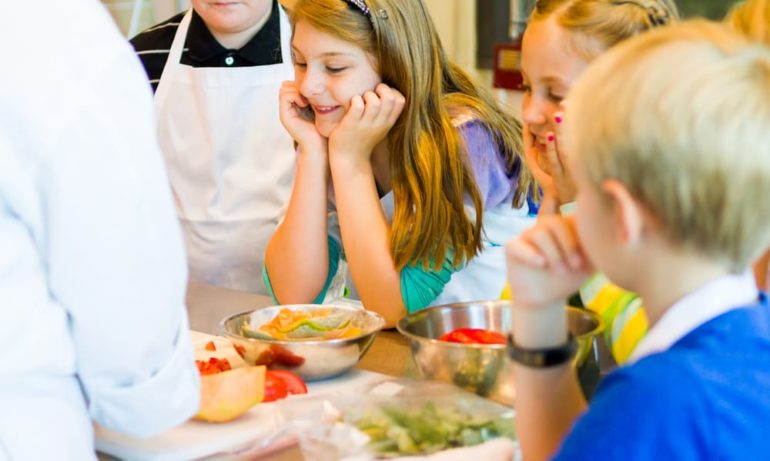Food Tank had the opportunity to speak with Rozanne Gold, acclaimed chef and pioneer of New American cuisine. Gold is the author of 13 cookbooks, including Kids Cook 1-2-3, which features three-ingredient recipes for young chefs, and Eat Fresh Food: Awesome Recipes for Teen Chefs, the only book of its kind to be reviewed in the Science section of the New York Times. On February 28, 2015, Gold presented a segment of her “Every Kid A Critic: Understanding the Components of Taste” program at the Kids’ Food Festival in New York City. Gold is a four-time winner of the James Beard Award and a recipient of the Julia Child First Book prize at the International Association of Culinary Professionals’ (IACP) Cookbook Awards, and was first chef to New York Mayor Ed Koch.
Food Tank (FT): How were you inspired to redirect your message of simple cooking toward kids and teens?
Rozanne Gold (RG): I used to carry a cookbook around with me when I was five. The images made me swoon, and recipes connected me to a larger world outside my apartment in New York. My early memories are in the kitchen with my mom; I saw food moving from an interior experience to a very outer experience that is now connecting us in new ways. For me, food is about pleasure. “Swoon,” “pleasure,” “allure”: these are not words we hear in the national conversation! My Kids Cook 1-2-3 is so appealingly illustrated that you want to eat the book. It is not childish in any way; rather, it is about respect for children and the experience of cooking. It exudes charm, ignites creativity, and approaches the process of cooking, enabling children to begin and complete a task. And unlike homework, you can eat the results! It is a way to connect to one’s history and to the greater community.
FT: Does your message of limited ingredients and preparation time have implications for environmental sustainability?
RG: Yes, without a doubt. Limiting the number of ingredients cuts down on waste and extraneous packaging, and using fresh ingredients from the farmers’ market can help as well. But most importantly, using only three ingredients encourages me to use every single part of the food: I boil the peelings of asparagus and use them in a salad; I was the first to use crispy carrot tops as a garnish; I use the zest, juice, and segments of fresh citrus; I’ve made salads out of beets and beet greens. “Simple” does not mean “simplistic,” and it doesn’t always mean “easy.” Simple is getting to the essence of experience—it’s actually a rather sophisticated idea.
I also created the Hudson River Club in 1987. It was the first restaurant to focus on local ingredients and featured the first New York state wine list. The difficulty back then was that there was hardly any distribution, because farmers’ markets were just starting. We became more and more niche: first it was the New American cuisine, then regional cuisine, then local cuisine, then eating in your own zip code, and then growing it yourself! And that’s where we are today: hyper-local, super-personal. I think the personalization of being able to affect the food system is very powerful and exciting, and that’s what I’m offering to kids through my program.
FT: Your efforts to combine simplicity with elegance and your sophisticated presentation are perhaps a signature of your cookbooks. Does this balance shift when writing for kids and working with them directly?
RG: Yes, I care even more about them! Kids like simple, elemental tastes. I am acutely aware of hitting some primary components, such as bitter or sour, and very aware of balance. Children embrace the magic of the three-ingredient approach to cooking; they love to imagine turning chocolate, eggs, and butter into a cake!
Eat Fresh Food, on the other hand, uses as many ingredients as needed for its recipes. The moniker F.R.E.S.H. stands for “farmer-friendly, ripe-ready, easy-exciting, sustainable, honest-healthy.” These ideas should be embraced by everyone, not just young chefs. The idea is to produce dishes that are kid-friendly but sophisticated, using only fresh ingredients.
FT: Throughout your career, how has culinary education changed? How can kids contribute in new ways to building a better food system?
RG: I am a bit of a rebel in this respect and don’t always agree with the narrative around school food; I think we are stressing intake without talking about pleasure. I realized that for children, no one armed them with words to use, so they would say “yuck” without any idea about why they might not like something. I wanted kids to understand that our taste palettes, and the ways that we experience food, are completely unique, like our fingerprints. I worked with many teens on Eat Fresh Food, and if they didn’t like a recipe, I challenged them to make it better. But they needed knowledge and experience to do it! That’s why I created my program, “Every Kid A Critic,” to give kids the vocabulary, information, and resources to make analytical food choices and understand the components of taste. The program was borne out of years of lecturing about food and wine pairings and the exquisite food vocabulary generally reserved for adults. That’s the experience of pleasure I want to share with kids; I want to move them from saying “yuck” to saying “I love umami.” Wish me luck!













